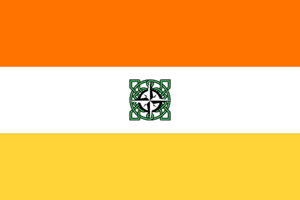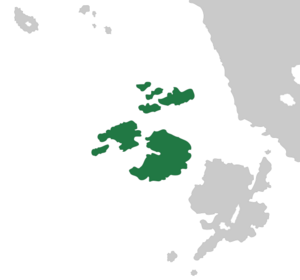New Ardmore
This article is non-canonical either because it refers to out-of-character content, the associated nations have left the region, or the information has been retconned. Accordingly, its content should not be considered to be part of the canonical structure of the region's lore.
|
This article is a work-in-progress because it is incomplete and pending further input from an author. Note: The contents of this article are not considered canonical and may be inaccurate. Please comment on this article's talk page to share your input, comments and questions. |
New Ardmore (Gaelic: Ardmór Nua, Kiravic: Inoardmóra) is an overseas region of the Kiravian Collectivity comprising an archipelago in the Odoneru Ocean. Laying off the coast of mainland Levantia north of Ardmore, New Armore has a predominantly Garán heritage it shares with Ardmore and the Urcean region of Carolina, with further influences from Kiravia, to which it has been politically linked for over XX years. Originating as a rump state of Ardmore, the territories of New Ardmore - initially the Republic of Ardmore - became a formal protectorate of Kiravia in 19XX, with further integration establishing it as a free state under the Collectivity.
| Free State of New Ardmore Saorstát Aird Mhóir Nua (Gaelic) Helviārka Inox Ardmór (Coscivian) | |
 Flag | |

| |
| Sovereignty | |
| Theme | |
| Capital | Ardagh (Ardağon) |
| Largest City | Baltimore-Dundalk |
| Population | 3,531,159 |
| Ceann Stáit | Martin Umhaill (FAM) |
| Tánaiste | Máire mac Dubhghaill (FAM) |
| Stanora seats | 3 |
| Official languages | Garán Gaelic, Kalvertan Coscivian |
| Postal Abbreviation | ARD |
History
Pre-civil war
Civil war and republican period
Death of the President-Regent and civil turmoil
Protectorate period
With the civil apparatus of the Republic of Ardmore in shambles after five decades of rule by the President-Regent, pro-democratic elements managed to seize power. With an invasion by Ardmore appearing imminent, the new provisional government struck an accord with Kiravia to become a protectorate. Kiravian influence had been significant on the island since the 1950s, and a potential protectorate was proposed as early as 1960, though the prevailing Kirosocialist regime made such an agreement unlikely. The Treaty of Electorsbourg in 1989 officially transferred the islands to Kiravian control, who established the Free State of New Ardmore; the Republic's government transferred its sovereignty to the Free State the same day the treaty was signed. As part of the Treaty, the new Free State no longer claimed sovereignty over the entirety of Ardmore and used the territorial name of "New Ardmore", long used abroad to refer to the rump state, as its new official name.
Government
| Member | Party | First Elected | |
|---|---|---|---|
| Angus MacIntyre | Fíanna Aird Mor (KR) | 21201 | |
| Séamus Ó Dónaill | Fíanna Aird Mor (KR) | 21201 | |
| Tomás Ó Flaithbertaigh | Aontú (CSU) | 21201 | |
Relations with the Levantine Union
Political Landscape
The main divide in New Ardmore's political culture is between those with a more Levantine outlook - oriented toward Urcea and Fíannria and generally in favour of closer integration with the Levantine Union, and those with a more Boreal outlook - oriented toward Kiravia and Faneria and generally in favour of closer integration with the wider Kiravian Collectivity and Federacy.
| Party | Seats | Caucus | Platform | |
|---|---|---|---|---|
| PARTY NAME AMA PLAIDUL |
22 / 42 |
RKC | Centrism, Levantinism | |
| Republican-Renaissance Party Plaiduv Kéarita'inoguamsk |
10 / 42 |
FRA | Conservatism, Borealism | |
| Levantian Union Party Levantiax Anūrarisēx Plaiduv |
3 / 42 |
none | Levantinism (pro-accession), Liberal conservatism | |
| Aontú Întúv |
5 / 42 |
CSU | Christian democracy, Status-quo | |
| Other Party Plaiduv Inox Isdul |
1 / 42 |
Doin' ur mom. | ||
| Whiggamore Party Ƕigamórix Plaiduv |
1 / 42 |
KFA | Doin' ur mom. | |
| JACOBITES??? Íakovindurya??? |
1 / 42 |
KFA | Doin' ur mom. |
Local Governance
Administratively, New Ardmore is divided into twenty countyships (siorrachdan). These are subdivided into burghs in built-up areas and hundreds in rural areas, both of which are in turn subdivided into townlands.
The Kiravian addressing system is in use in New Ardmore, with lots being numbered within townlands or quarters. Numbered blocks (ram) and circuits (kontruv) are rare outside of some newer suburban developments near Dundalk, with most address components represented by common geographic names.
Law
The legal system of New Ardmore is based heavily on Brehon law principles and traditions, especially in matters of civil law or equity, and Brehon law was the main mechanism for social regulation and dispute resolution in Ardmore for most of its history, supplemented by canon law with the coming of Christianity. As statelike institutions began to replace clan-based governance, Ardmorean law took cues from Urcean jurisprudence while retaining most of its traditional character, and since integration with Kiravia it has been influenced by Cosco-Kiravian law.
New Ardmore adopted a moratorium on capital punishment in 21196. Traditionally, most executions were carried out by firing squad on a sandspit called Deadman's Point, located three kilometers from Ardagh.
Society
Ardmore has an Insular Celtic culture with noticeable traces of Pretannic influence from early in its history, shaped by local geographic and climatic conditions, the Catholic faith, and contact with Coscivian civilisation by virtue of its status as a Kiravian federal subject. The state is rather homogeneous: 88% of the population of New Ardmore are ethnic Gaels. Most of the remainder are Coscivian-Kiravians or of Levantine backgrounds other than Gaelic. Ardmorean Gaelic, which is largely though not fully mutually intelligible with the varieties spoken in the Kiravian Gaeltacht, Faneria, and Fiannria and contains many archæic and endemic features, is spoken by 85.6% of the population as a first language. Kiravic Coscivian is an auxiliary official language and is widely understood in urban areas, though most long-term Coscivian residents in the islands find it necessary to learn Gaelic to get by.
Most Ardmorean Gaels do not have static surnames and are identified instead by patronymics and clan names (e.g. Séamus Mac Néill Ó Séaghdha, "Séamus, son of Neil, of the clan Séaghdha [lit. 'grandson of Séaghdha']"), whereas most other Gaelic communities, including those in Great Kirav and most - if not all - of Levantia, have converted such names into conventional surnames.
The overwhelming majority of the population is of the Roman Catholic faith, and Levantian Catholic authorities visiting the island report that virtually the entire population attends Mass on Sundays. Intense cultural isolation has allowed for the preservation of religious rites and practices - some deriving from Insular Celtic Christianity and some of local origin - that have disappeared elsewhere in the Catholic world. A smaller number of parishes in New Ardmore belong to the Insular Apostolic Communion and three to the Ancient Celtic Church in Kiravia.
Economy
The economy of New Ardmore was historically agrarian, and agriculture remains an important activity across much of the archipelago, although services now employ the majority of the Ardmorean workforce. Ardmoreans engaged in many maritime-related business ventures during the age of the sale, ranging from legitimate commerce, ship repair and oceanic fishing to smuggling, privateering, and piracy. These activities declined with advances in shipping technology, which led to a long-term economic downturn for the archipelago, but have since been replaced with growing tourism, distillation, and healthcare industries.
Remittances from Ardmoreans working in other parts of the Kiravian Federacy and Levantine Union are crucial to the islands' economy, with up to 26% of Ardmorean households classified as remittance-dependent by the state's Department of Human Economics.